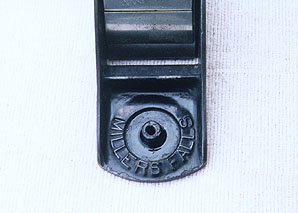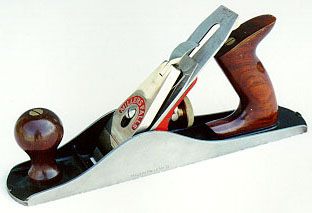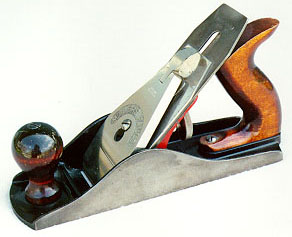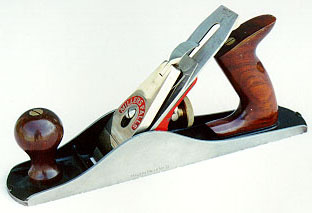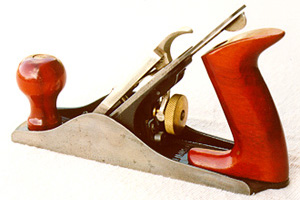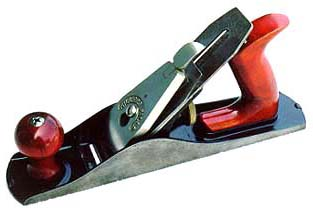Premium Bench Plane Type Study: Difference between revisions
No edit summary |
No edit summary |
||
| Line 1: | Line 1: | ||
__NOTOC__ | |||
One of the problems encountered in a study of the company’s bench planes is that catalog illustrations could be as much as twenty years out of date. Texts describing the tools were often astonishingly inaccurate and descriptive errors could remain uncorrected for a decade or more. I’ve also come to the conclusion that the company never threw a spare part away, parsimony which muddies classification considerably. This type study is based on the premium bench planes manufactured by Millers Falls. As such, it will not be particularly helpful for the study of the firm’s economy and mid-quality planes. | One of the problems encountered in a study of the company’s bench planes is that catalog illustrations could be as much as twenty years out of date. Texts describing the tools were often astonishingly inaccurate and descriptive errors could remain uncorrected for a decade or more. I’ve also come to the conclusion that the company never threw a spare part away, parsimony which muddies classification considerably. This type study is based on the premium bench planes manufactured by Millers Falls. As such, it will not be particularly helpful for the study of the firm’s economy and mid-quality planes. | ||
== Type 1 (1929 - ca. 1936) == | == Type 1 (1929 - ca. 1936) == | ||
[[File:Millers Falls Type 1.png|right|none]] | |||
# Rosewood/cocobolo tote and knob. | # Rosewood/cocobolo tote and knob. | ||
# Tote and knob attached to steel posts by means of cylindrical brass nuts. | # Tote and knob attached to steel posts by means of cylindrical brass nuts. | ||
| Line 24: | Line 25: | ||
== Type 2 (first production: ca. 1936 - ca. 1941) == | == Type 2 (first production: ca. 1936 - ca. 1941) == | ||
As Type 1, except: | As Type 1, except: | ||
[[File:Millers Falls Type 2.png|right|none]] | |||
# The words “Millers Falls,” encircling the front knob, no longer cast into bed. | # The words “Millers Falls,” encircling the front knob, no longer cast into bed. | ||
# Number identifying the size of the plane no longer cast into the bed, but is stamped on the outside of the left cheek, as is the manufacturer’s name. | # Number identifying the size of the plane no longer cast into the bed, but is stamped on the outside of the left cheek, as is the manufacturer’s name. | ||
| Line 43: | Line 44: | ||
== Type 3 (ca. 1941 - 1949) == | == Type 3 (ca. 1941 - 1949) == | ||
As Type 2, except: | As Type 2, except: | ||
[[File:Millers Falls Type 3.png|right|none]] | |||
# Cocobolo handles and totes replaced by a light-colored hardwood with a walnut-toned stain. | # Cocobolo handles and totes replaced by a light-colored hardwood with a walnut-toned stain. | ||
# Leading edge of tote exhibits an ever-so-slight ogee curve. | # Leading edge of tote exhibits an ever-so-slight ogee curve. | ||
| Line 62: | Line 63: | ||
== Type 2 (second production: 1949-1953) == | == Type 2 (second production: 1949-1953) == | ||
[[File:Millers Falls Type 2 Take 2.png|right|none]] | |||
'''Note:''' The Millers Falls Company announced the post-war return of “solid rosewood” (i.e. cocobolo) knobs and handles to its bench planes on page 161 of the May 5th, 1949, issue of ''Hardware Age''. Since the change marks the return to an earlier design, a new type designation has not been created for these planes. | '''Note:''' The Millers Falls Company announced the post-war return of “solid rosewood” (i.e. cocobolo) knobs and handles to its bench planes on page 161 of the May 5th, 1949, issue of ''Hardware Age''. Since the change marks the return to an earlier design, a new type designation has not been created for these planes. | ||
| Line 78: | Line 80: | ||
== Type 4 (1953 - 1966) == | == Type 4 (1953 - 1966) == | ||
As Type 3, except: | As Type 3, except: | ||
[[File:Millers Falls Type 4.png|right|none]] | |||
# Tote and knob are manufactured of goncalo, rather than cocobolo and coated with a thick red-orange varnish stain. | # Tote and knob are manufactured of goncalo, rather than cocobolo and coated with a thick red-orange varnish stain. | ||
# Horn is noticeably shorter, and a slight belly is no longer seen on the leading edge of the tote. | # Horn is noticeably shorter, and a slight belly is no longer seen on the leading edge of the tote. | ||
| Line 91: | Line 93: | ||
== Type 5 (1966 - 1978) == | == Type 5 (1966 - 1978) == | ||
As Type 4, except: | As Type 4, except: | ||
[[File:Millers Falls Type 5.png|right|none]] | |||
# One piece lever cap replaces the famous three-point lever cap. | # One piece lever cap replaces the famous three-point lever cap. | ||
# Semi-circular recess containing inscription “Millers Falls” on the front face of lever cap no longer painted red. | # Semi-circular recess containing inscription “Millers Falls” on the front face of lever cap no longer painted red. | ||
| Line 110: | Line 112: | ||
* Some early examples have a smoother surface on the inside of castings. | * Some early examples have a smoother surface on the inside of castings. | ||
* Some early examples with “Made in U.S.A.” cast into bed behind the frog. | * Some early examples with “Made in U.S.A.” cast into bed behind the frog. | ||
[[Category:Knowledge Base]] | |||
[[Category:Tool Identification]] | |||
[[Category:Planes]] | |||
Latest revision as of 20:33, 15 January 2021
One of the problems encountered in a study of the company’s bench planes is that catalog illustrations could be as much as twenty years out of date. Texts describing the tools were often astonishingly inaccurate and descriptive errors could remain uncorrected for a decade or more. I’ve also come to the conclusion that the company never threw a spare part away, parsimony which muddies classification considerably. This type study is based on the premium bench planes manufactured by Millers Falls. As such, it will not be particularly helpful for the study of the firm’s economy and mid-quality planes.
Type 1 (1929 - ca. 1936)
- Rosewood/cocobolo tote and knob.
- Tote and knob attached to steel posts by means of cylindrical brass nuts.
- Red painted frog.
- The words “Millers Falls” cast into the bed, encircling the front knob.
- Number identifying the size of the plane cast into bed.
- “Made in U.S.A.” cast into bed behind the frog.
- Front knob is positioned within a raised ring cast into bed.
- Fork adjustment is cast and painted red.
- Recessed brass adjustment nut.
- Hinged, nickel-plated three-point lever cap.
- Reverse of the lower piece of lever cap has text “PAT APLD. FOR” cast into reverse side.
- Red paint in semi-circular recess containing the inscription “Millers Falls” on the front face of the lever cap.
- Nickel-plated chip breaker.
- Trade mark on cutter stamp consists of a small inverted triangle superimposed on a larger inverted isosceles trapezoid.
- Trapezoid contains the text “Miller Falls Tools”
- Lower triangle contains the text “Since 1868”
- “Made in U.S.A.” stamped under trademark.
- Width of the cutter, in inches, stamped under “Made in U.S.A.” stamp.
Type 2 (first production: ca. 1936 - ca. 1941)
As Type 1, except:
- The words “Millers Falls,” encircling the front knob, no longer cast into bed.
- Number identifying the size of the plane no longer cast into the bed, but is stamped on the outside of the left cheek, as is the manufacturer’s name.
- Front knob bedding unique to Millers Falls is adopted. A series of raised ridges radiate from post tapped to accept knob attachment screw and extend out to a raised ring which encircles the base of the knob. Invisible when the knob is in place, the ridges eliminate the inadvertent rotation of the knob during use. Unfortunately, the raised ridges act as tiny wedges if the knob attachment screw is over-tightened, causing splits in the knob.
- Fork adjustment is now pressed steel and less likely to crack if subjected to undue pressure.
- Domed screws secure frog to bed.
Variations: treatment of inverted triangle on cutter stamp.
- Inverted triangle on cutter may contain the text “Since 1868”
- Inverted triangle on cutter may contain only the date “1868”
Variations: substitution for brass components.
- Recessed steel adjustment nut may be substituted for brass nut.
- Tote and front knob may be attached to steel posts by means of cylindrical steel nuts rather than brass nuts.
Type 3 (ca. 1941 - 1949)
As Type 2, except:
- Cocobolo handles and totes replaced by a light-colored hardwood with a walnut-toned stain.
- Leading edge of tote exhibits an ever-so-slight ogee curve.
- Handles and totes held in place with a blued steel screws, rather than posts with cylindrical nuts.
- Recessed steel adjustment nut.
Variations: lever cap
- Semi-circular recess containing inscription “Millers Falls” on the front face of lever cap contains no paint.
- Semi-circular recess containing inscription “Millers Falls” on the front face of lever cap contains red paint.
Variations: cutter stamp
- Inverted triangle on cutter contains the text “Since 1868”
- Inverted triangle on cutter contains only the date “1868”
Note: An example of a type 3 bench plane in the original box with the sales receipt inside has been observed on an online auction site. The receipt was dated 1942. The changes in fittings and finish found on type 3 were likely the result of wartime shortages.
Type 2 (second production: 1949-1953)
Note: The Millers Falls Company announced the post-war return of “solid rosewood” (i.e. cocobolo) knobs and handles to its bench planes on page 161 of the May 5th, 1949, issue of Hardware Age. Since the change marks the return to an earlier design, a new type designation has not been created for these planes.
The post-war era also marked the return of brass adjustment nuts and brass attachment nuts for tote and knob. During the transition, older steel components were used on some planes.
Variations: treatment of inverted triangle on cutter stamp.
- Inverted triangle on cutter may contain only the date “1868”
- Inverted triangle on cutter may contain no date.
Variations: substitution for brass components.
- Recessed steel adjustment nut may be substituted for brass nut.
- Tote and front knob may be attached to steel posts by means of cylindrical steel nuts rather than brass nuts.
Type 4 (1953 - 1966)
As Type 3, except:
- Tote and knob are manufactured of goncalo, rather than cocobolo and coated with a thick red-orange varnish stain.
- Horn is noticeably shorter, and a slight belly is no longer seen on the leading edge of the tote.
- Knob and tote again attached to steel posts by means of cylindrical brass nuts.
- Frog now painted black.
- Earliest examples fitted with recessed brass adjustment nuts. Later production no longer recessed.
Note: The earliest known illustration of a type four plane appears on the cover of a 1953 Christmas promotion titled: Gifts Men Want. The company's Catalog 49: Hand Tool Section, Revised to April 1955 is the first catalog to illustrate the type. Although decades-old illustrations represent the bench planes in the main part of the catalog, artwork for the new No. 1100 plane display unit depicts the re-design. Descriptions for the bench planes are identical to those used in 1949 except the word “goncalo” replaces the word “rosewood.”
Although red frogs continue to be mentioned in catalog descriptions through 1967, a type 5 plane other than a black frog has yet to be reported. (The company was often slow to update catalog texts.)
Type 5 (1966 - 1978)
As Type 4, except:
- One piece lever cap replaces the famous three-point lever cap.
- Semi-circular recess containing inscription “Millers Falls” on the front face of lever cap no longer painted red.
- Knob and tote are attached with Phillips-head screws.
- “Made in U.S.A.” no longer cast into bed behind the frog.
- Adjustment nut is not recessed but is plated steel rather than brass.
- Frog adjustment screws are now Phillips-type.
- Castings are no longer highly finished before painting.
- Bench planes in sizes larger than the No. 9 no longer have a fastening screw in the toe of the tote. A small tube inserted into the bottom of the tote which anchors into a hole in the bed serves instead.
- There is no longer a frog adjustment screw and tab mounted to the rear of the frog.
- No markings of any type appear on the cutter.
Variations:
- Some early examples with slotted screws.
- Some early examples with non-recessed brass adjustment nuts.
- Some early examples with cutters marked with Millers Falls logo where triangle contains no date.
- Some early examples have a smoother surface on the inside of castings.
- Some early examples with “Made in U.S.A.” cast into bed behind the frog.
